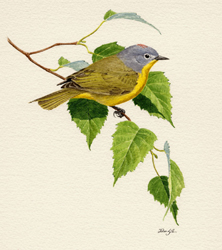Breeding Bird Atlases (BBA)
Find a Bird - BBA1
Breeding Bird Atlas 1 Species Accounts
Nashville Warbler
Vermivora ruficapilla
Egg Dates
May 21 to July 21
Number of Broods
one

A century and a half ago, two-thirds of the land in Massachusetts had been cleared for agriculture. Accordingly, the Nashville Warbler, essentially a bird of habitat that was formerly farmland, especially of fields grown up with saplings and shrubs, was comparatively rare and little known. The species was also a scarce migrant throughout the East. Alexander Wilson, who inappropriately named the species based on a specimen he secured in spring migration in Nashville, Tennessee, hardly knew the bird in life.
As increasing amounts of farmland were abandoned and allowed to regenerate to woodland, the Nashville Warbler began to increase in numbers, and by the turn of the century it had become quite common in many areas. Today, it is a widespread breeding bird, with its Massachusetts stronghold in the drier uplands of the western counties; it is now less common than formerly in eastern sections of the state.
The first Nashville Warblers arrive in Massachusetts in late April, and spring migration continues throughout May. During this time, they can be found in a wide range of habitats, including parks, orchards, and woodland edges. Like other warblers, the Nashville seems to be in perpetual motion, flitting about in the mid- and upper-level branches, now plucking an inchworm from the edge of an emerging leaf, now pausing to break into ebullient song, now dashing out of sight into the thick foliage. Almost completely insectivorous, the Nashville Warbler takes a variety of adult and immature insects, including beetles, flies, and grasshoppers. Caterpillars make up a significant part of the diet.
The song of the Nashville Warbler is a typical wood-warbler “nonwarbled song.” It is regularly comprised of two parts, the first a series of high, double-note phrases and the second a series of lower-pitched notes delivered at about twice the speed of the first part. To human ears, the song approximates the following: see it, see it, see it, see it, ti, ti, ti, ti, ti, ti, ti. Both sexes give chip or pink call notes.
On its breeding ground, the male is in full song, advertising his presence from early May to early June. Uncharacteristic of warblers once nesting is underway, the singing drops off markedly and the birds become very inconspicuous. Some males exhibit another brief burst of singing once the young have fledged (Meservey). Although this species occupies diverse types of breeding habitats across its North American range, in Massachusetts it is generally found nesting only in two types. In the southeastern part of the state, open Scrub Oak woodlands seem to be preferred, while, in the central and western sections, Nashville Warblers most often choose pastures and fields overgrown with Red Cedar and dense stands of young Gray Birch and Quaking Aspen.
Nests are well concealed in vegetation and placed on or very near the ground, and a nest in Rehoboth was hidden among low bushes and grass in an old pasture grown up with many saplings (ACB). Five recent nests from Worcester County were all on the ground: 2 in grass below clumps of young Gray Birch, 1 in a weed clump in an opening in front of aspens, 1 in a weed clump near a stone wall along a gas pipeline, and 1 in weeds and grass near a path at the edge of an overgrown field (Meservey, Blodget).
Nests are constructed of rootlets, strips of bark, and leaves, and they are lined with hair and fine grasses. The clutch of four or five creamy, lightly speckled eggs is incubated by the female for 11 to 12 days. A nest in Princeton contained three eggs on May 25 (Blodget), and 1 nest from the Millbury area held four eggs on June 8 (DKW). Three nests from Pelham were all discovered during June (Nice 1933). Both parents provide food for the nestlings, initially bring- ing small caterpillars and later adding more hard-bodied insects. The young are usually ready to leave the nest in 10 to 12 days. Nestlings have been recorded in Massachusetts from June 10 to June 20 (Meservey), although later dates would be expected considering the July egg dates. In southern Worcester County, there is little evidence of renesting, with breeding activity concentrated from late May to late June (Meservey). Adults feeding one to three fledglings were observed from June 28 to July 6 (Meservey).
With the advent of early fall and completion of the molt, Nashville Warblers are on the move. Some begin to depart in late August, and many transients pass throughout September and early October. As in spring, migrants can be observed in a variety of habitats. Occasionally, individuals have attempted to overwinter in thick coastal vegetation, but few, if any, survive through December. The wintering grounds extend from the southern United States south through Mexico to Guatemala.
Map Legend and Data Summary
Atlas 1 data collected from 1975-1979


Note: fairly common in second-growth woodland, especially in logged-over areas and in pine-oak scrub of the southeastern coastal plain
Brian E. Cassie



